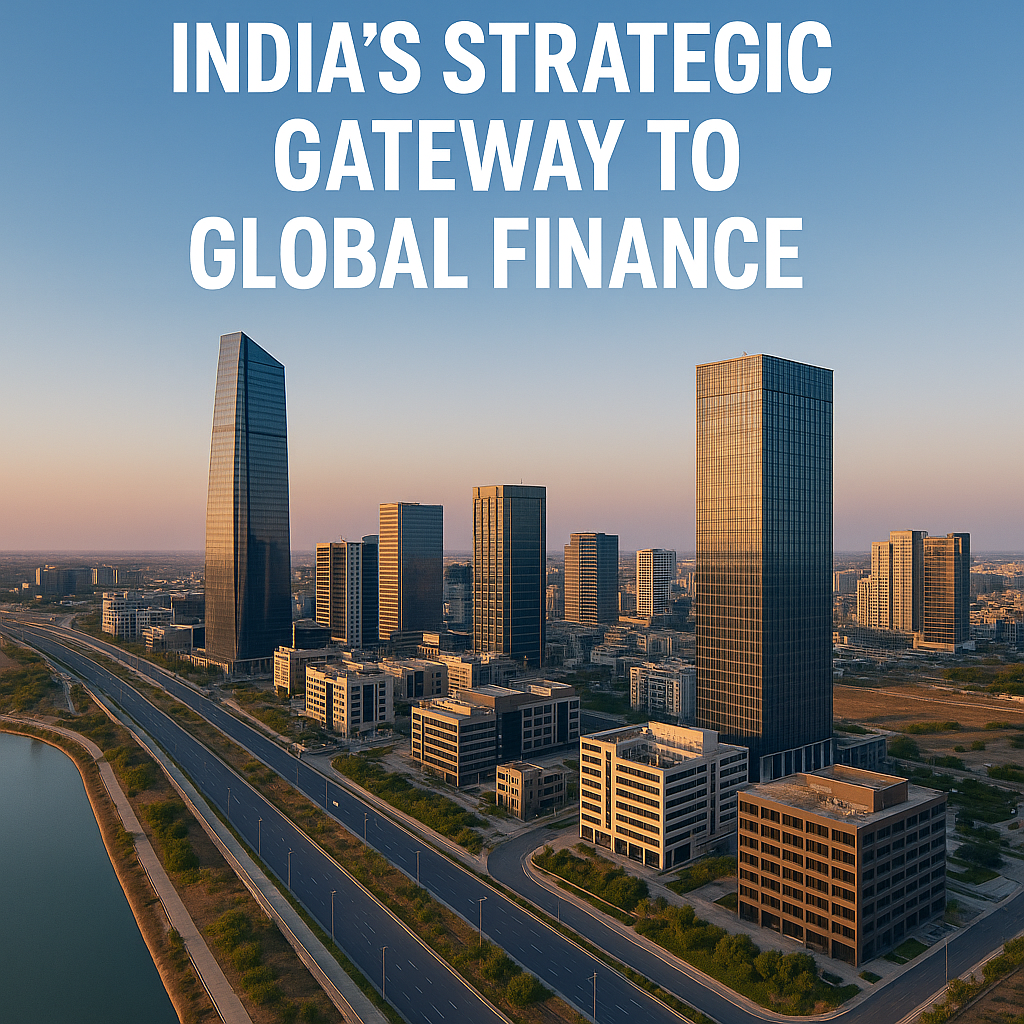- Introduction to GIFT City and Its Legal-Economic Status
The Gujarat International Finance Tech-City, commonly referred to as GIFT City, is a landmark initiative by the Government of India aimed at creating a world-class financial centre within the country. Strategically located in Gandhinagar, Gujarat, GIFT City is designed to be a state-of-the-art financial ecosystem, combining robust regulatory frameworks with cutting-edge infrastructure.
Although geographically situated in India, GIFT City operates as a Special Economic Zone (SEZ) and is treated as a foreign jurisdiction for regulatory purposes. This unique designation allows it to function as an International Financial Services Centre (IFSC), facilitating cross-border transactions without the typical regulatory frictions found in India’s domestic markets.
Financial institutions based in GIFT City can treat their operations, investments, and deposits as offshore, enabling Indian banks, NBFCs, insurance providers, and capital market entities to offer global financial products in foreign currencies. These institutions operate under international compliance norms, positioning GIFT City alongside global financial hubs such as Singapore, Dubai, and Hong Kong. As a result, GIFT City becomes a vital testing ground for phased liberalization of India’s capital account.
- Outbound Investment Opportunities and Mechanisms through GIFT CITY
GIFT City significantly streamlines outbound investment opportunities for Indian residents under the RBI’s Liberalised Remittance Scheme (LRS). Its NSE International Exchange (NSE IFSC) enables Indian investors to access global equities, ETFs, and thematic investment options.
A notable innovation is the introduction of unsponsored depository receipts (UDRs), which allow for fractional ownership in high-value international stocks. For example you have a positive view on the Apple stock and want to take exposure. Stock costs $199, the unit being US dollar (USD). At a conversion rate of about 84.5 to a USD, the price per share of Apple would be approximately Rs.16, 800. Let’s say the price of one UDR, with Apple as the underlying asset, at NSE IFSC is $7.95. Therefore Apple Inc., trading at approximately $199, can be accessed via a UDR priced at $7.95 (approximately ₹672), enabling investors to own 4% of a share. This structure provides exposure to dividends, capital gains, and corporate actions while lowering the entry barrier for middle-income investors.
These transactions fall under the $250,000 LRS annual limit and require remittances through authorized dealers with full compliance on KYC, currency conversion, and regulatory procedures. As of now, seven SEBI-registered brokerage firms facilitate access to NSE IFSC, offering advisory, custody, and execution services. The platform is expected to expand its offerings to include ETFs, global bonds, and diversified portfolios.
- Inbound Investment Pathways and Regulatory Considerations
GIFT City is not just an outbound investment hub; it also serves as a key channel for inbound investments. It enables NRIs, foreign portfolio investors (FPIs), and overseas institutions to invest in Indian markets while adhering to RBI and SEBI norms.
These funds, usually denominated in foreign currencies, are allocated to Indian equities, bonds, and structured investment vehicles. However, to prevent misuse such as round-tripping—a method of routing domestic funds offshore and reinvesting them back into India—regulatory bodies enforce strict disclosure and monitoring protocols.
Additionally, funds held in foreign currency within IFSC accounts are not deemed to be remitted into India until they are converted to INR and invested domestically. This ensures regulatory clarity on capital flow classification, taxation, and foreign investment thresholds.
- Key Benefits and Challenges
Benefits
- Enhanced Global Access
GIFT City provides Indian investors with streamlined, regulated access to global markets, eliminating the need for foreign brokerage accounts and high transaction costs. - Currency Arbitrage Advantage
INR depreciation—averaging 3–4% annually against the USD—can enhance foreign investment returns. For instance, an investment made at USD/INR 83 and exited at 86 gains purely from exchange rate movement. - Transparent Taxation and Compliance
Operating within GIFT City allows investors to benefit from low transaction costs, international audit standards, and applicable DTAA benefits.
Challenges
- Low Investor Awareness and Limited Offerings
Despite its potential, GIFT City remains underutilized due to limited awareness and a narrow scope of investible global securities. - LRS Limitations and Procedural Complexity
The $250,000 LRS ceiling may restrict HNI strategies, and the current compliance requirements for fund transfer and documentation may deter retail investors.
5. Policy Implications and Investor Guidance
GIFT City represents a shift in India’s economic and regulatory approach, offering a controlled environment to pilot liberal financial models. Between FY 2021–22 and FY 2023–24, LRS-based outward investments in equities and bonds doubled—indicating rising investor interest in international diversification.
Strategic Recommendations
- Broaden Asset Classes: Expand beyond U.S. stocks to include ETFs, bonds, and funds from Europe, Asia, and emerging markets.
- Digitize Compliance: Leverage fintech solutions to simplify KYC, AML, and remittance workflows.
- Increase Investor Literacy: Use awareness campaigns, workshops, and institutional outreach to educate investors.
- Enable Tech-Driven Platforms: Integrate investment channels with the National Single Window System (NSWS) and mobile-first platforms.
- Guidance for Investors
- Retail investors should work with certified advisors to align global investments with long-term goals. Remittance strategies should be phased to manage currency risk, especially for education and retirement planning. HNIs may explore using GIFT City-based structures such as AIFs for broader global exposure while ensuring full compliance with anti-round-tripping norms.
Conclusion
- GIFT City is more than just a symbolic step in India’s financial evolution—it is a strategic and structural leap forward. By bridging domestic savings and international capital markets, it fosters financial inclusion and diversification under a transparent regulatory canopy.
- With the right blend of policy support, investor engagement, and technological innovation, GIFT City can become a cornerstone of India’s vision to emerge as a $5 trillion economy. It is not just a financial district, but a national strategy in motion—a gateway not only to global finance, but to India’s economic aspirations.


Comments are closed